Lecture 25 - Center of Mass
1/11
There's no tags or description
Looks like no tags are added yet.
Name | Mastery | Learn | Test | Matching | Spaced |
|---|
No study sessions yet.
12 Terms
center of mass (cm)
Any system (or single object) is composed of many particles, but we can consider it as a point by locating a special point in space called the object’s ___________.
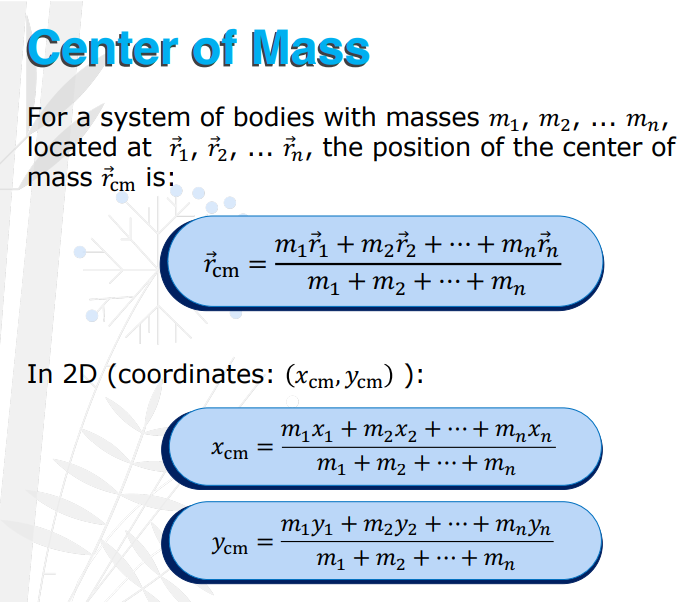
center of mass (cm)
Water molecule: Has three atoms, but can be represented as a point at ___________ (x mark in the figure)
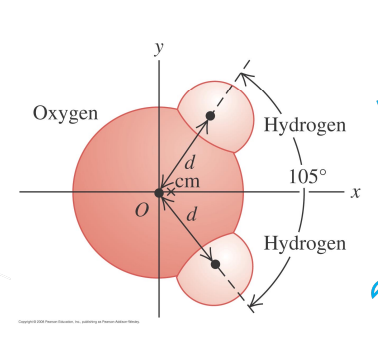

(Product of masses and X/Y)/ Sum of masses
For a system of bodies with masses m1, m2, …. mn, located at r1, r2, … rn, the position of the center of mass rcm is:
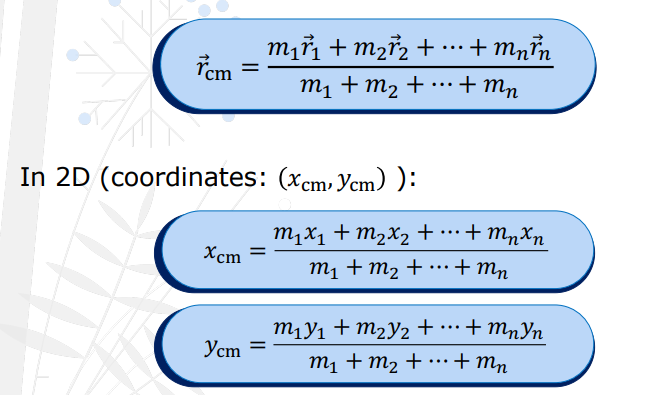
geometric center
For geometrically symmetrical objects (sphere, cube, cylinder) of uniform density, the center of mass is the _____________.
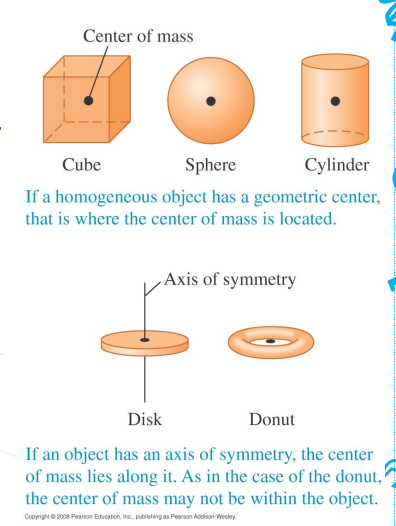
(m1 + m2 + ….. + mn)Vcm = m1v1+ m2v2 + ….. + mnvn
Why is MVcm = Ptotal?
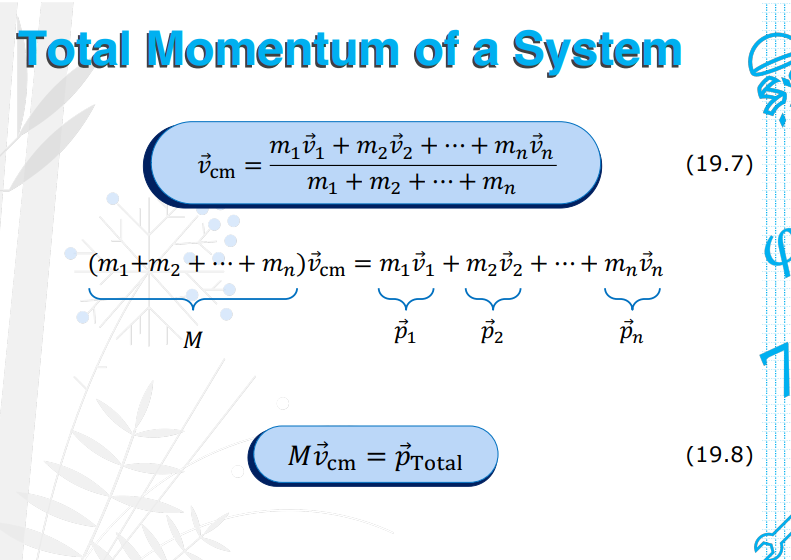
external forces
For a system consisting of many particles/objects, all the forces that act internally would cancel out each other due to Newton’s 3rd law. Only __________ will contribute to Fnet.
acm = Fnet / Mtotal
Calculate the acceleration of the center of mass: Fnet = Macm
mB = (mAxA-mAxcm)/ (xcm-xB)
Calculate the mass of a particle B. (ma+mb)xcm = mAxA + mBxB
constant
For a system of particles on which ∑Fext = 0. The total momentum is _________, and the velocity of the center of mass is also __________.
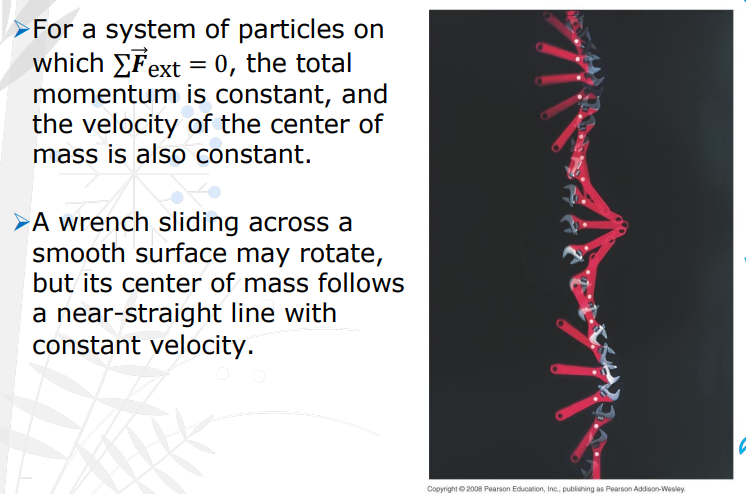
Total Momentum / Total Mass = Velocity of Center of Mass
Puck. During hockey practice, two pucks are sliding across the ice in the same direction. At one instant, a 0.18 [kg] puck is moving at 16 [m/s] while the other puck has a mass of 0.14 [kg] and a speed of 3.8 [m/s]. What is the velocity of the center of mass of the two pucks?
![<p>Puck. During hockey practice, two pucks are sliding across the ice in the same direction. At one instant, a 0.18 [kg] puck is moving at 16 [m/s] while the other puck has a mass of 0.14 [kg] and a speed of 3.8 [m/s]. What is the velocity of the center of mass of the two pucks?</p>](https://knowt-user-attachments.s3.amazonaws.com/0dee28bf-f786-4fe5-a013-d84f19265a38.png)
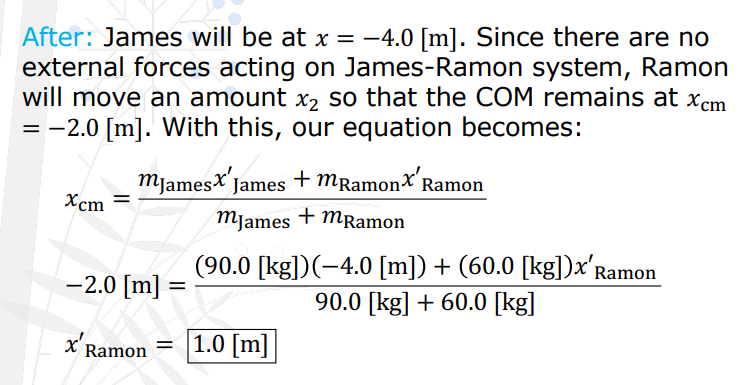
Calculate for initial center of mass, plug into the second equation with the change in position to find, the missing change in position.
James (mass: 90.0 [kg]) and Ramon (mass: 60.0 [kg]) are 20.0 [m] apart on a frozen pond. Midway between them is a mug of their favorite beverage. They pull on the ends of a light rope stretched between them. When James has moved 6.0 [m] toward the mug, how far and in what direction has Ramon moved?
![<p>James (mass: 90.0 [kg]) and Ramon (mass: 60.0 [kg]) are 20.0 [m] apart on a frozen pond. Midway between them is a mug of their favorite beverage. They pull on the ends of a light rope stretched between them. When James has moved 6.0 [m] toward the mug, how far and in what direction has Ramon moved?</p>](https://knowt-user-attachments.s3.amazonaws.com/d4af696c-a016-42b5-8c80-4165278a7226.png)
Find the range to get the Center of Mass, after this make sure to set the system of equations to gain the position of x2.
A banana was thrown with an initial velocity of 7.0 [m/s], 15° from the horizontal. A second before it lands on the ground, the banana exploded, splitting the banana into two pieces. The two pieces reached the ground at the same moment. If the 0.10 [kg] piece ended up with a horizontal distance of x1 = 1.0 [m] from the launching position, where did the 0.020 [kg] piece end up?
![<p>A banana was thrown with an initial velocity of 7.0 [m/s], 15° from the horizontal. A second before it lands on the ground, the banana exploded, splitting the banana into two pieces. The two pieces reached the ground at the same moment. If the 0.10 [kg] piece ended up with a horizontal distance of x1 = 1.0 [m] from the launching position, where did the 0.020 [kg] piece end up?</p>](https://knowt-user-attachments.s3.amazonaws.com/c607deeb-cd95-40f6-a5f9-6929421d9f2b.png)